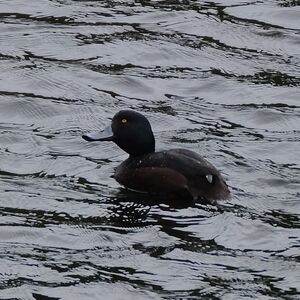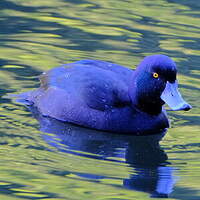New Zealand Scaup
Aythya novaeseelandiae - Fuligule de Nouvelle-Zélande
Identification
This is a small, entirely dark scaup. Male and female can easily be distinguished in the wild. The male's back, neck and head are black while the flanks are dark brown, the golden yellow eye is clearly visible and the bluish beak is ended by a black nail. The same beak can be found on the female, but she differs from the male in the absence of black (the full body is dark brown), the brown eye and the presence of white vertical bars at the base of the beak (present in half of the females). Juveniles look like the females but lack the white marks at the base of the beak.
In flight, the underside is very light and the upper wing very contrasting; the dark coverts oppose the white remiges (only their tips are dark, creating a dark trailing edge). Note that, contrary to what is seen in the Australian scaup, Aythya australis (the only species that can be confused in New Zealand), the large white wing bar does not reach the body.
Subspecific information monotypic species
Foreign names
- Fuligule de Nouvelle-Zélande,
- Porrón maorí,
- zarro-maori,
- Maoriente,
- maori cigányréce,
- Nieuw-Zeelandse Topper,
- Moretta di Nuova Zelanda,
- nyazeelanddykand,
- Maoridykkand,
- chochlačka tmavá,
- polák novozélandský,
- Newzealandsk Troldand,
- uudenseelanninsotka,
- morell de Nova Zelanda,
- ogorzałka nowozelandzka,
- Новозеландская чернеть,
- ニュージーランドスズガモ,
- 新西兰潜鸭,
- 紐西蘭潛鴨,
Voice song and call
Habitat
Behaviour character trait
Flight
Dietfeeding habits
Reproduction nesting
Couples of New Zealand Scaup form at the start of the Australian spring (late September - early October). Sometimes loose colonies are noted. The nest is well-hidden in dense vegetation, close to water. It is usually built with reeds leaves and strands of grass. The average number of eggs laid is 4 to 8 (with a known record of 15); the female incubates these alone for about a month. Young birds are not able to fly until two or two and a half months old.
Geographic range
Threats - protection
IUCN conservation status
concern
in the Wild
threatened
evaluated
Even though its numbers were greatly reduced due to hunting in the first decades of the 20th century (which led to its disappearance in almost all plain areas), the species is not considered threatened. It has been protected since 1934 and has benefited from the creation of many dam lakes, especially in the South Island. Effective reintroduction operations have been carried out in the North Island. However, at the end of the 20th century, the population was between 5,000 and 10,000 individuals, which is still low.
Sources of information
- IOC World Bird List (v14.2), Gill, F and D Donsker (Eds). 2024-04-18.
- Guide des canards, des oies et des cygnes, Steve Madge
- The hand guide to the birds of New Zealand, Robertson Hugh et Heather Barrie
- Vol. 1 - Handbook of the Birds of the World, Josep del Hoyo-Andrew Elliot-Jordi Sargatal
- Avibase, Lepage Denis
- Waterbird Population Estimates, Simon Delany Derek Scott
Other sources of interest
 Specification sheet created on
01/08/2023 by Georges Olioso
Specification sheet created on
01/08/2023 by Georges OliosoTranslation by AI Oiseaux.net
© 1996-2025 Oiseaux.net
- Accipitriformes
- Aegotheliformes
- Anseriformes
- Apodiformes
- Apterygiformes
- Bucerotiformes
- Caprimulgiformes
- Cariamiformes
- Casuariiformes
- Charadriiformes
- Ciconiiformes
- Coliiformes
- Columbiformes
- Coraciiformes
- Cuculiformes
- Eurypygiformes
- Falconiformes
- Galliformes
- Gaviiformes
- Gruiformes
- Leptosomiformes
- Mesitornithiformes
- Musophagiformes
- Nyctibiiformes
- Opisthocomiformes
- Otidiformes
- Passeriformes
- Pelecaniformes
- Phaethontiformes
- Phoenicopteriformes
- Piciformes
- Podargiformes
- Podicipediformes
- Procellariiformes
- Psittaciformes
- Pterocliformes
- Rheiformes
- Sphenisciformes
- Steatornithiformes
- Strigiformes
- Struthioniformes
- Suliformes
- Tinamiformes
- Trogoniformes

























